| Author |
Message |
|
Gregory J. Liebau
Location: Dinuba, CA Joined: 27 Nov 2004
Posts: 669
|
 Posted: Thu 01 Oct, 2015 10:27 pm Post subject: Researching Eastern Scandinavian Armament c. 1200 Posted: Thu 01 Oct, 2015 10:27 pm Post subject: Researching Eastern Scandinavian Armament c. 1200 |
 |
|
Hello folks,
I've been prompted to start investigating the armament of Swedish and Finnish men-at-arms around the turn of the 13th century. Last night I brought up the thread concerning the silver inlaid swords from eastern Finland and Patryk Nieczarowski just posted an excellent reproduction he made of an early topfhelm based on a carved stone font from Lyngsjo, Sweden..
I am grouping Sweden and Finland together in this research because Finland was dominated by the Kingdom of Sweden during the later 12th and early 13th century, until wars with Novgorod over Karnelia weakened the Swedish presence for a time. Most of Scandinavia had been Christianized in theory for some time by 1200, and the German presence in the Baltic was maturing to a point where Riga was established in 1204, and quickly came to dominate local affairs in the home region of the Latts.
I cannot find any other particular artistic evidence regarding Swedish or Finnish armament from this period. There are parallels with German topfhelms in other art, and the continental influence on the development of mail and kite shields seems an inevitable part of the process. However, it's interesting to note that while the visored helmets worn by the knights on the Lyngsjo font are clearly from the period around 1200, they do not seem to be wearing mail chausses or mittens, features which were also becoming common by that time. Of course, many bits of continental art also reflect the slow transition. Interestingly, the hauberks they wear also seem to be long in the waist. What I'd love to see is more evidence to corroborate or dismiss any of these superficial considerations on the font.
Also, are there any other weapons discovered which date from this era in Eastern Scandinavia? Whatever there is, it would be great to begin compiling it all here. Are there any good books that cover the subject even briefly? I have not seen the Osprey title about Scandinavian armies of the Middle Ages, and am sure it has some decent references, but perhaps nothing that cannot be disclosed here by those in the know. Thanks in advance for your contributions and questions. Cheers!
-Gregory
|
|
  |
 |
J. Nicolaysen

|
 Posted: Fri 02 Oct, 2015 5:42 am Post subject: Posted: Fri 02 Oct, 2015 5:42 am Post subject: |
 |
|
| Quote: | | I have not seen the Osprey title about Scandinavian armies of the Middle Ages, and am sure it has some decent references, but perhaps nothing that cannot be disclosed here by those in the know. |
By chance, I just got a used copy of Osprey's Medieval Scandinavian Armies (1) 1100-1300, knowing full well the usual limitations of Osprey books. This one in particular I don't really recommend. It's very general and the bibliography seems to be made up of mostly general sources on Scandinavian history, and then most of Oakshott's work. One thing I do like about most Osprey titles are the original photos of weapons or art; at least it gives me a starting place.
There is one mention of Finland containing the "earliest archaeological Scandinavian evidence for what later came to be known (inaccurately) as the Norman sword. This had a more acute point and an almond-shaped pommel. It was also this design that later became the dominant form-though with several variations-up to the 13th century." This is probably from Oakshott's Records of the Medieval Sword.
Other than that, there's not much at all about Finland in the book. The most interesting-sounding source from the bibliography to me at least might be E. Christiansen's The Northern Crusades: The Baltic and the Catholic Frontier 1100-1525. (1980) But that is really what I am interested in researching in this time and place right now. So there, I've saved you some money! 
|
|
  |
 |
Craig Peters

|
 Posted: Sun 04 Oct, 2015 8:06 am Post subject: Posted: Sun 04 Oct, 2015 8:06 am Post subject: |
 |
|
I have Eric Christiansen's The Northern Crusades. It is a superb introduction to the subject, and I would imagine it's still the best one available in English. However, it does not have what Greg needs. I just skimmed the section on the Swedish incursions to Finland from 1200-1292 A.D. but there is no mention of the arms and armour carried by either side.
In the Further Reading section to do with this time period, the only books given are Sawyer and Sawyer, Medieval Scandinavia (for the Swedish background) and John Lind, “Early Russian-Swedish Rivalry” Scandinavian Journal of History XVI/4 (1991). The only source specifically given for Finland is A History of Finland ed. E. Jutikkala (London 1962) chapters 1-3 by K Pirinen. But I doubt that any of these will provide the specifics Greg is looking for.
The best you are probably going to get is the baptismal font that Patryk Nieczarowski posted in his thread on the late 12th century full-faced helmet he has for sale, and which Greg has already seen.
In case, Greg, you haven't seen them, there's also these images, although neither are of comparable quality to the baptismal font: http://www.warfare.altervista.org/12/Valthjof...night2.htm and http://www.warfare.altervista.org/13/Bengtsson-Seal.htm.
|
|
  |
 |
|
Mart Shearer
|
 Posted: Sun 04 Oct, 2015 9:58 am Post subject: Posted: Sun 04 Oct, 2015 9:58 am Post subject: |
 |
|
There's the 13th century Kodasoo kettle hat from the Danish Duchy of Estonia.
http://gladius.revistas.csic.es/index.php/gla...ew/238/244
I would presume trade of such item across the entire region would be likely.
ferrum ferro acuitur et homo exacuit faciem amici sui
|
|
  |
 |
|
Gregory J. Liebau
Location: Dinuba, CA Joined: 27 Nov 2004
Posts: 669
|
 Posted: Mon 05 Oct, 2015 3:20 am Post subject: Posted: Mon 05 Oct, 2015 3:20 am Post subject: |
 |
|
Hello guys,
Thanks for the input! I own and have read Christiansen's The Northern Crusades, and it is as broad and valuable work on the subject as one could hope for. However, details about commerce in Scandinavia and details regarding arms and armour are almost as scarce as they are in the contemporary chronicles written by priests and monks on which Christiansen relies for most of his information. Alas, as Craig pointed out, that work simply does not have what I'm looking for!
I shall continue my search and post anything I come across. Cheers!
-Gregory
|
|
  |
 |
|
Mikael Ranelius
|
 Posted: Thu 08 Oct, 2015 10:23 am Post subject: Posted: Thu 08 Oct, 2015 10:23 am Post subject: |
 |
|
Seal of Birger Brosa, jarl of Sweden, late 12th century:
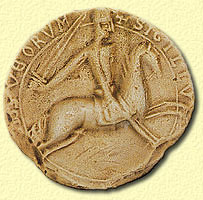
Seal of Karl Döve (Karl the Deaf), jarl of Sweden ca 1200

A baptismal font from Bro, Gotland (late 12th century)
Hejde, Gotland (ca 1200)
Skogs-Tibble, Uppland late 12th century
Algutsrum, Öland, late 12th century
Gualöv, Skåne, late 12th century
Halla, Gotland, early 13th century:
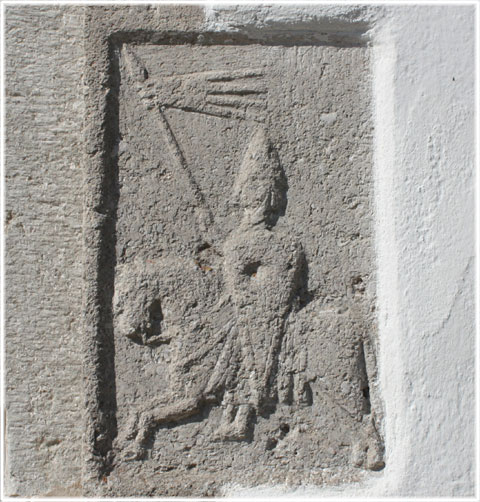
Grötlingbo, Gotland, late 12th century:
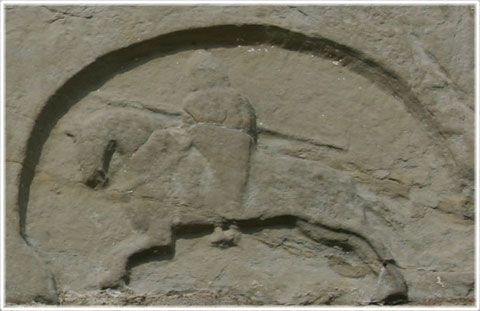
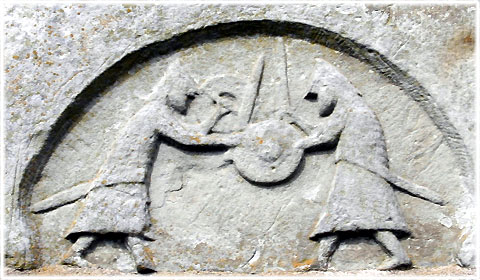
Väte, Gotland, late 12th century:
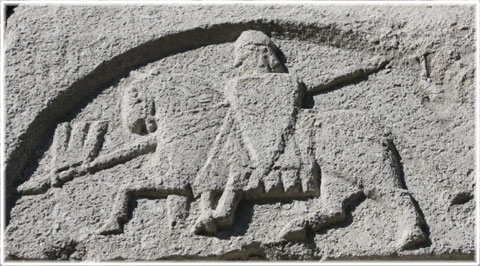
|
|
  |
 |
|
Niels Just Rasmussen
|
 Posted: Sat 10 Oct, 2015 6:45 am Post subject: Posted: Sat 10 Oct, 2015 6:45 am Post subject: |
 |
|
Based on the images we have from the high middle ages, it seems that the Danish and Swedish noblemen participating in the Baltic Crusades were dressed basically as German noblemen. Basically a fashion statement and showing you were now part of Catholic Christian Europe.
The interesting part is how the common soldiers armed themselves!
When the Danish and Swedish kings called for "Leding" (expeditio), then the general populace had to supply their own weapons!
The Jutland Law of 1241 (Jydske Lov) states the following for them common soldiers:
I wrote about the law more extensively here: http://myArmoury.com/talk/viewtopic.php?t=32114&highlight=
Book 3, chapter 4:
Old Danish:
Vm wapnæ.
Hwar styræs man scal hauæ full mansz wapnæ. oc thæræ til et armbyrst oc thre tylft pilæ. oc een man thær scivtæ kan thæræ mæth. of han kan æi sialf scivtæ. oc hwar hafnæ bondæ thær a sciip ær. scal hauæ skiold[1] oc thry folk wapnæ. swærth oc kætælhod. oc spiwt.
Modern Danish:
Om Vaaben.
Hver Styrismand skal have fuldt Vaabenudstyr og desuden en Armbrøst og tre Tylvter Pile og en Mand, der kan skyde med den, hvis han ikke selv kan skyde. Og hver Havnebonde, der er paa Skibet, skal have Skjold og tre Folkevaaben: Sværd, Kedelhat og Spyd.
English:
About Weapons
Every Styrisman must have a full weapon-equipment and furthermore have a crossbow and 3 tylvter [Tylt/Tylvt = 12] arrows and a man that can shoot it, if he can't shoot it himself. And every "harbour-farmer" on the ship must have a shield and 3 peoples-weapons: Sword, Kettlehat and Spear.
NB:
A "skipæn" = "ship district" had to provide/build one ship for the leding-campaign (lat. expeditio).
A "hafnæ" = "harbour-district", that had to provide one man with weapons for the ship (a harbour-farmer, Dk Havnebonde).
So the common Danish Soldier from 1241 - while campaigning in the eastern baltic - would have a shield (not type specified, so could still be a round shield) a sword, a kettle-hat and a spear!
They had to supply it themselves by law, so no "army standard" could be expected.
Armour is only specified for high ranking people (including the Styrisman, that had to have "brynje" - chain mail), but not for the common soldier. So they would have whatever they could afford.
This skipæn-hafnæ division of the country meant that a Danish ship built for the "leding" (expeditio) had to have room for 40-42 rowers and the Styrismand. You had around ~800 skipæn in Denmark in the viking ages, though with the 1200's expansion in the Baltic it rose probably to 1000 skipæn.
If we just calculate with 800 ships with each 40 rowers and 1 styrismand for each ship we reach a max potential of 33.000 men for the campaign all with minimum weapon-sets listed below......800 styrismænd gives a min. cavalry force of 800, boosted since also Nobles, Bishops and the King with their men and horses travelled on their own bigger ships.
|
|
  |
 |
|
Niels Just Rasmussen
|
 Posted: Sat 10 Oct, 2015 7:01 am Post subject: Posted: Sat 10 Oct, 2015 7:01 am Post subject: |
 |
|
Mikael Ranelius gave this info from the Swedish Södermannalagen from 1327, which shows an increased development in the required armour worn by the common soldier, compared to the +80 years older Danish law!
Maille Coif, padded jack or coat-of plates are now specified as obligatory!
So it makes a huge difference armour-wise, whether it is 1200's or 1300's Scandinavian "common soldiers", that is your target.....
"Sweden, Södermannalagen (provincial law of Södermanland), 1327:
Thessa lund scal konungs ledung ut biuda. at snækkiur ok scutur sculu til redo uæra um pingizdagha tidh med them redom flær til höre. Thætta svulu hamnu uapn uæra Skiolder ok suærd. spyut ok iarnhatter. Huar hamna scal haua muzo eller penzara eller ok plato. huar hamna scal ok hanbugha ok threa tylpte sköte haua. Af huarre hamnu. scal fiughur pund ok tiughu. tuælotina flesk ok thridiungen smör. aghi sidan konunger uald aftaca sua mykit hanum thækkiz. Thæfta scal lyusas huarn huitta sunnudagh i strengenæs.
According to the passage each crewman who were called upon to serve in the ledung (fleet) should be armed with shield (skiolder), sword (suærd), speer (spyut), kettle hat (iarnhatter), maille coif (muzo), padded jack (penzara) or a coat-of-plates (plato). Also required are bow (hanbugha ) and three dozen arrows (threa tylpte sköte)."
Source: http://myArmoury.com/talk/viewtopic.php?t=32114&highlight=
If we go to 1100's, the Norwegian laws (mostly written down in the 1100-1200's) - you seem to have a full weapon set comprising of shield, spear and then either sword OR axe.
So that is without both kettle-hat and armour specification for the common soldier!
If your target is ~ 1200 the common soldier would arm himself according to his own funds; so most would only have these above specified weapons (and probably more axes than swords, to reduce costs), and generally no armour as the choice of a helmet would likely be primary, if you had extra money to spare.
Remember increased weapon requirements is a TAX on the people! If you don't meet the requirements, it means punishment!
As the Christian Kings increase in power compared to the free population of farmers, the Kings also slowly increase the taxation on the population (though with some backlashes causing uprisings)!
If your target is the noblemen (men-at-arms) I would reckon they generally follow German fashion, though some Scandinavian anachronistic features could be present occasionally!
For instance the dueling scene shown above from Grötlingbo, Gotland, late 12th century: Viking round shields.
Dueling could have retained anachronistic features, based on a very long tradition!
It seems they are still using the shields actively "the viking way" (shield-binding) and NOT keeping them as "mobile armour" as was the more continental way of using them!
What would be interesting is if any Scandinavian noblemen around 1200 still looked to an Orthodox Eastern Fashion (Novgorod), as the Rus did?!
I haven't seen that though.....
|
|
  |
 |
|
Gregory J. Liebau
Location: Dinuba, CA Joined: 27 Nov 2004
Posts: 669
|
 Posted: Sat 10 Oct, 2015 10:09 am Post subject: Posted: Sat 10 Oct, 2015 10:09 am Post subject: |
 |
|
Mikael,
Thank you so much for all of this visual evidence! One of the most intriguing aspects of the original baptismal font from Lyngsjo that I posted was the long mail hauberks worn by the men-at-arms. A number of the sculptures and even the painted evidence that you have provided suggests that this is in fact a trend to some extent. Whether or not the hauberks were so long, it is clear at least that the gambesons worn beneath them reach to the knees on several of the depicted figures. Also, long tunics beneath both the hauberk and gambeson, which were in vogue in the late twelfth century in Western Europe (via Sicily and Outremer, most likely), also seem to be shown in at least two of the depictions presented.
I also see no concrete (or stone) evidence to suggest that mail chausses were popular at this time in Sweden, when they were already becoming well-integrated into the panoply of the typical central European man-at-arms. However, only three or four of the figures clearly distinguish the mail hauberk and show no traces of the same pattern on the legs, so that is a tentative theory!
Also, the predominance of the kite shield, which clearly derived from a central European model, is also obvious by the late twelfth century. That is, with the exception of the duelers, as Niels pointed out in his last post, and which may be considered a cultural anachronism due to its particularity.
Very
Niels,
Thank you very much for the legal evidence regarding the armament of the common soldier. This was not particularly what I had in mind when I created this thread, but it is certainly welcome information. Your keen consideration that over time the armament 'taxes' became more punitive with the increasing sway of the Christian kings in Scandinavia is an interesting one. The trend also makes it much less surprising that such a variety of armor was discovered at the site of the Battle of Wisby, which obviously occurred some decades after the last law you cited. Perhaps even the most common soldier on that battlefield would have been well-armored compared to what is usually considered "typical" for the period!
(p.s. Thanks for posting a link to the thread about muster regulations. I had not read most of that stuff and it's really interesting!)
Cheers!
-Gregory
|
|
  |
 |
|
Niels Just Rasmussen
|
 Posted: Sat 10 Oct, 2015 1:41 pm Post subject: Posted: Sat 10 Oct, 2015 1:41 pm Post subject: |
 |
|
| Gregory J. Liebau wrote: |
Thank you very much for the legal evidence regarding the armament of the common soldier. This was not particularly what I had in mind when I created this thread, but it is certainly welcome information. Your keen consideration that over time the armament 'taxes' became more punitive with the increasing sway of the Christian kings in Scandinavia is an interesting one. The trend also makes it much less surprising that such a variety of armor was discovered at the site of the Battle of Wisby, which obviously occurred some decades after the last law you cited. Perhaps even the most common soldier on that battlefield would have been well-armored compared to what is usually considered "typical" for the period!
(p.s. Thanks for posting a link to the thread about muster regulations. I had not read most of that stuff and it's really interesting!)
Cheers!
-Gregory |
Glad you could use the info, Gregory!
The common soldiers seems to have been very well armed in Scandinavia, because of the enforced Leding-system regulations [almost a men-at-arms except for having no horse and probably often armour thrown together - sometimes old fashioned? - to meet Leding-regulations].
Each "ship-district" also had to make sure to build a campaign ship and man it with a Styrisman (Captain) and each harbour-district had to man 1 person for the ship with the armour and weapons needed AND also provide supply for the campaign for that man; when the King called for Leding (expeditio).
All the Kings men (nobles under his rule which also includes "The Kings Men" in Danish Estonia) and Bishops with retinues also had to go on "Leding" on their own expenses! Danish Bishops were fighting Bishops often from the great Danish nobles families (especially the Hvide family).
So it means that the personal financial situation of the King didn't really change that much the army standard (only the personal strength and size of his own bodyguard - the Hird and the size and number of his personal ships besides the Leding Fleet).
So the general Danish soldier at Visby would (likely have been upgraded to the level of the Swedish 1327 law) have armour of some kind enough to meet requirements, kettlehat, shield, spear and sword and perhaps crossbow as a MINIMUM!
Both nobles and commoners were armed based on their own pocket and by the 1300's the requirements were pretty exacting as seen in the Swedish law for 1327.
So you didn't have "state armouries" providing weapons for the men at least not to my knowledge before much later in Scandinavian history [In Denmark probably first with the establishment of the Danish/Norwegian Navy in 1510].
The Hospitaller Knights, who were very prominent in Denmark, might have had some armoury-system of their own to provide for campaigns, but whether their produce anything locally or always imported it from Germany I do not know.
For those of you who read Danish, here are two books about the Crusades with some Danish focus on the Baltic Crusades.
1) Danske korstog - Krig og mission i Østersøen [Danish Crusades - War and Mission in the Baltic].
Review: http://www.historie-online.dk/nyt/bogfeature/korstog.htm
So covers the primary agents in politics and religion from 1095-1520.
2) Korstog ved verdens yderste rand - Danmark og Portugal ca. 1000 til ca. 1250 [Crusades at the outer edge of the world -Denmark and Portugal 1000-1250].
Review: http://www.historie-online.dk/nyt/bogfeature/b401103.htm
A comparison between Denmark and Portugal as crusading countries on the edge of the Christian world. It is focusing on the Crusading ideology existing on a high political level, which made for marriage alliances between notable crusading monarchs and princes.
[Danish King Valdemar II the Victorious married the Portuguese Princess Berengaria - daughter of Sancho I - in 1214]
|
|
  |
 |
|
|
You cannot post new topics in this forum
You cannot reply to topics in this forum
You cannot edit your posts in this forum
You cannot delete your posts in this forum
You cannot vote in polls in this forum
You cannot attach files in this forum
You can download files in this forum
|
All contents © Copyright 2003-2025 myArmoury.com — All rights reserved
Discussion forums powered by phpBB © The phpBB Group
Switch to the Basic Low-bandwidth Version of the forum
|

